It’s time for a LED Grow Light Shootout
With our first Midwestern winter in nearly a decade bearing down on us, we had to move my wife’s houseplant collection – raised in the ever-sunny desert Southwest – into the house from their summer home in our solarium.
Since there are no south-facing windows in the house large enough for her collection, we quickly realized we were going to need supplemental lighting. I traditionally have used good old-fashioned T8 or T5 4000K-6500K florescent shop lights for just about everything: my garage, workshop, and even my tropical plant collection (and have had successful results). But recently, as prices on LED lighting have come down to the price of florescent lighting, I have been switching over to LED shop lights one by one as my florescent lights have died. So I thought I might know a thing or two about LED lights.
But my wife wanted something that looked nicer than my LED shop lights, since the plants would be displayed in our family room. So we hit the internet to search for LED plant grow lights: There were “full spectrum” plant grow lights; there were Red/Blue – some people call them “Burple” – plant grow lights; there were combinations of the two; there were also lights with added ultraviolet and infrared LEDs. There were square panels, round panels, rectangular panels, there were strip lights, there were even “UFOs.”
My wife quickly found a stylish plant grow light she liked, and purchased it. I, on the other hand (as I’m prone to do), looked at the dazzling array of sizes, spectrum, and LED count offered, and the different way the output was measured, and promptly dove down a LED Plant Grow Light “rabbit hole,” as my friend Dave Ready, owner of Knotty Pine Beard Co. would say.
About a week later I looked up from my voluminous pile of notes, and realized all the research I have been doing on plant grow lights might be valuable to others in the same boat, and would make a great video for the website.
Let me interject here:
This is by no means a scientific study of LED Plant Grow Lights. This is a by-the-seat-of-your-pants LED Plant Grow Light comparison/shootout using some numbers that sound sort of science-y, but most of those numbers are provided by the manufacturer – which should always be taken with a grain of salt, and some are provided by me taking make-shift measurements in my studio that are at best sort-of accurate – and should be taken with a large science-y looking beaker full of salt.
OK, now back to our show:
The root of the problem is thus: A generic Google search for “LED grow lights” returns 222 million results.
Obviously I needed to winnow the results to a more manageable number.
So I decided I had to settle on some parameters.
Parameters
Availability
The first parameter was availability. Since people might be watching the video on YouTube or reading the article on RainforestStationPets.com from literally anywhere on the planet, I figured the lights I chose had to be universally available. That means I need a marketplace that is available anywhere in the world. A marketplace that offers stability and dependability, and backs up the products with its own infrastructure, even when sellers are sometimes questionable. Which led me to eBay and Amazon. As luck would have it, there are thousands of listings for “Plant Grow Lights” on eBay and Amazon. So I still needed to narrow down the search.
Price
The second parameter was price. There are plant grow lights ranging from less than $20 to several thousand dollars on both eBay and Amazon. I needed to narrow down my search substantially, and cost seemed the quickest way. As I waded through the lists of features for plant grow lights, I began to see a trend between features, light output, construction, and price. Up to about $30USD plant grow lights had pretty obvious limits to light output and features – some do not even have on/off switches (which I have no need for, as I use a power strip and/or a timer). From $30 to $50USD there was another grouping of plant grow lights with more light output, more features, and better construction materials. From there on up, you start getting into lights that are more aimed at professional nurseries, hydroponics, and those raising a cash crop (wink, wink, nudge nudge, if you know what I mean).
Since our original search was for plant grow lights for my wife’s houseplants, I decided I would stick to that scenario. And since RainforestStationPets.com is funded solely by advertising revenue and affiliate links (if you purchase something by following the links in this article, it costs you nothing extra, but we get a tiny commission off of each sale), the money to buy the products we test was coming out of my pocket. Which is by no means deep. So the price range was already set, as I couldn’t afford more that a few lights, even at the low end of the price spectrum of plant grow lights. So I set the price range with a maximum of $30, since that meshed well with both my budget and product feature ranges among LED plant lights.
I had a spare metal wire shelving set that has four shelves that are 18 inches by 48 inches, so that gives me three shelves that I can hang lights from. Set up with the top shelf at its highest level and the bottom shelf at its lowest, the middle two shelves could be spaced to give me about 22 inches of vertical space on three shelves (the uppermost shelf is too close to our eight foot ceiling to mount lights over it). So I have three shelves to use for my plant grow light comparison. The bottom shelf would be the “control” of this plant grow light “experiment,” that is, set up like I normally do, with three four foot LED shoplights. Since those LED shoplights are also the length of the shelf, that precludes using any of our test plant grow lights on that level. That leaves two shelves, on which I can probably mount two plant grow lights on each shelf, or at a maximum three lights, but then bleed-over of light from one unit to the next would become almost certain.
Two shelves, with two lights, so I have to find four plant grow lights under $30.
Spectrum
The third parameter would be spectrum. Visible light is only a narrow band of the electromagnetic spectrum that ranges from gamma rays at the shortest wavelengths to radio waves at the longest wavelengths. Visible light falls between about 400 nanometers wavelength (what we see as blue light) and 700 nanometers wavelength (what we see as red light).
One of the questions for which I sought an answer was if the red/blue spectrum LED plant grow lights actually gave better results than full spectrum plant grow lights. The concept is that since objects appear to be the color of the portion of the visible light spectrum that they reflect, and plants appear to be green, they are reflecting green light rather than using it for photosynthesis. Green light falls right in the middle of the visual light spectrum between blue and red, and by using LEDs that don’t emit light in that range, energy can be saved that would otherwise simply be reflected by the plant.
One complication to that theory is that if you look at the sensitivity range of the human eye, it looks like a bell curve with the highest sensitivity smack dab in the green light wavelengths. So, part of the reason we see plants as green, is because that’s where we see color best. Plants may appear a different color to a creature more sensitive to blue, or even ultraviolet (the wavelengths just beyond blue) light.
Part of this red/blue theory is almost certainly a hold-over from the days prior to LEDs, when commercial growers needed light of much higher intensity than they could achieve with either incandescent or florescent lighting. The main types of high intensity lighting that were available were High Pressure Sodium (HPS) and Metal Halide (MH) bulbs. By coincidence HPS lights are reddish, and MH lights are blueish. Growers found that plants grew best in their vegetative state under Metal Halide (bluish light) but flowered better under High-Pressure Sodium (reddish light).
But HPS and MH bulbs also emit a significant amount of light across the spectrum. LEDs can be engineered to emit much more precise frequencies of light, so blue LEDs emit very little green or red light, and red LEDs emit very little green or blue light. There are those who argue that the plants growing under the old High-Pressure Sodium and Metal Halide were benefiting much more from those other wavelengths in the green part of the visible light spectrum than we realized. So we still have both red/blue LED plant grow lights, and “full-spectrum” lights that include the green light frequencies, which more closely match our visible light sensitivity, so appear to us as white light. Because full-spectrum plant grow lights look more like sunlight, your plants appear more natural than they do under a red/blue plant grow light, an important consideration for a display of houseplants such as my wife’s.
So I need to find both red/blue plant grow lights, and full-spectrum plant grow lights for this shootout. To eliminate crossover between the red/blue and full-spectrum plant grow lights, one shelf will have two red/blue plant grow lights, the other two full-spectrum plant grow lights.
Other deciding factors:
Reviews
Reviews offer a glimpse into other people’s experiences with the products you are considering purchasing, so they can be very valuable in your decision-making. You can even limit your searches to products that have achieved a certain level of good reviews. I worry about any product that has less than a 4.5 out of 5 rating. That said, I’ve gotten a lot of products that came with cards telling me when I post a review I may win a gift card. So positive reviews are somewhat suspect. Because of that, I like to look at the negative reviews and see if there are trends about durability and usability.
Construction materials
At the price level we are shopping, there are going to be concessions made, many of them involving durability of the materials from which the product is manufactured. As much as possible I looked for metal components and some level of waterproofing.
Eliminating factors: Ultraviolet and Infrared LEDs – Ultraviolet in strong doses can degrade the clear plastic domes of my Super Sprouter mini-terrariums and it’s questionable how much even gets through them anyway. Ultraviolet radiation is also damaging to the human eyes – and I assume dog eyes – over prolonged exposure, and these grow lights are going to be on in my studio pretty much any time I am in it. And if I’m in my studio, it’s a safe bet my dogs are, as well. Infrared light is felt as heat, which can cause the plastic Super Sprouter domes to warp and not fit well. Visible light LEDs already produce some infrared spectrum which they radiate as heat. Getting rid of heat will probably be a bigger challenge than needing to add to it.
Bestsellers: a great place to start
Amazon has best-seller lists for everything. However just as with music albums and literature, sometimes the best-selling items are not the best items for your intended use, so those rankings are a great place to start, but I ended up deviating from them substantially.
So for all that said, below are links to the products we finally decided on, some for better reasons than others. On the linked pages each product is represented by a snapshot of all the factors we looked at, followed by discussion (some might say rationalization) for the purchasing decisions we made, and light meter readings of the lights in situ.
Addendum
You will notice there are additional lights from the two-per-shelf original plan. Once we installed the original lights, it was obvious we needed more to completely cover the shelves, see illuminance readings in Figures 1A and 2A.
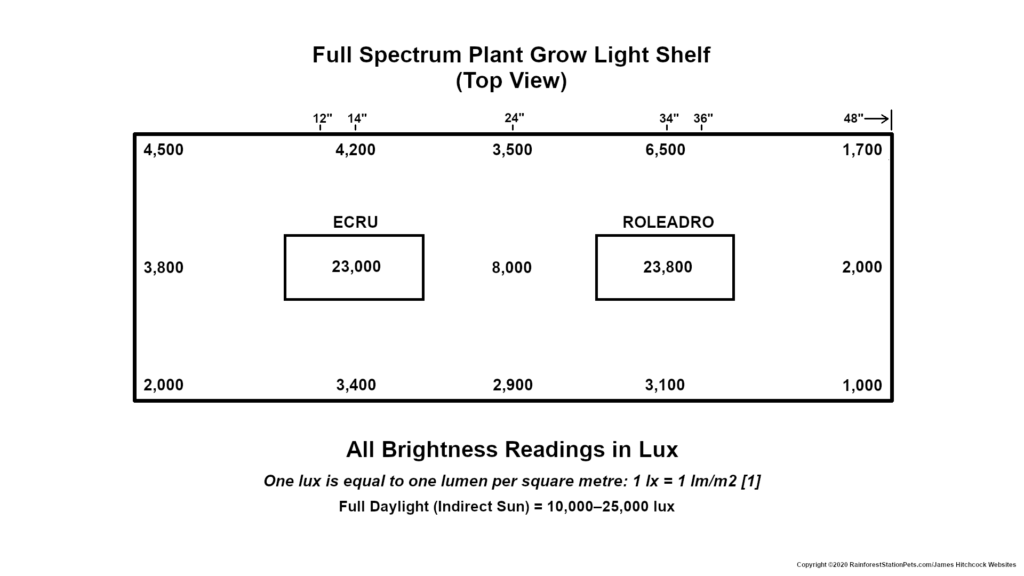
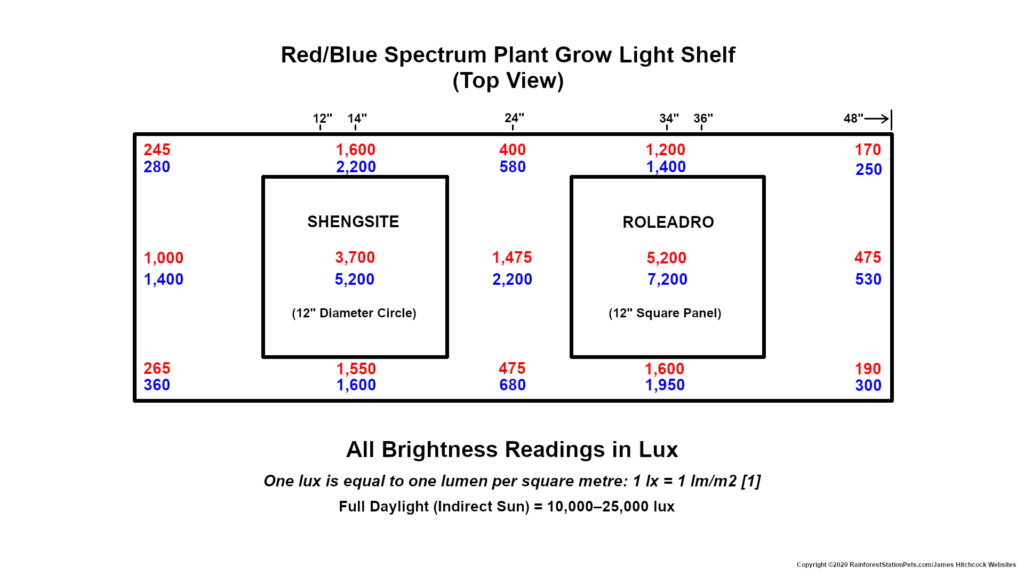
We needed an extra light on the full-spectrum shelf, and two on the red/blue shelf. You can see the difference in illumination (in lux) in figures 1A and 2A.
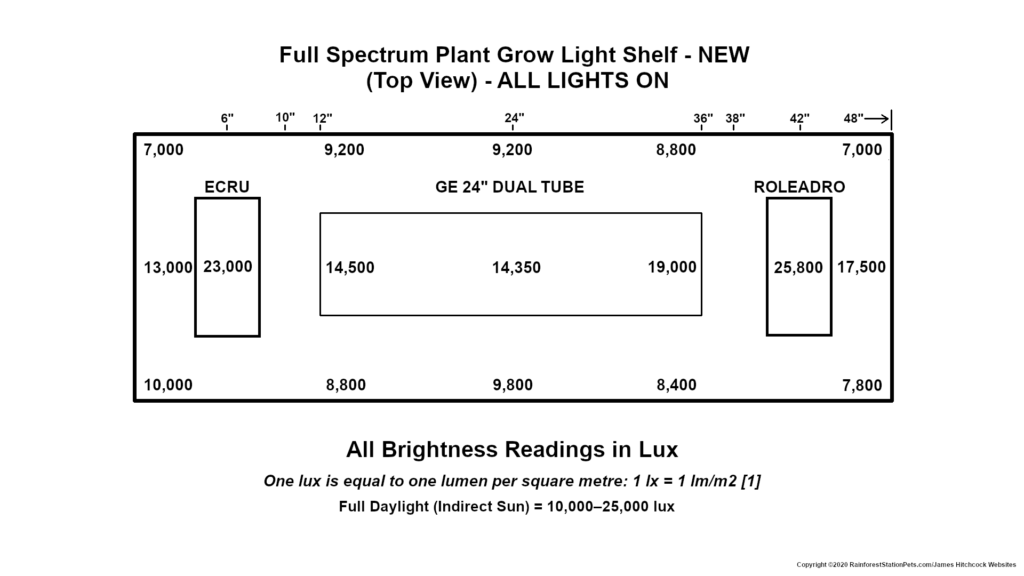
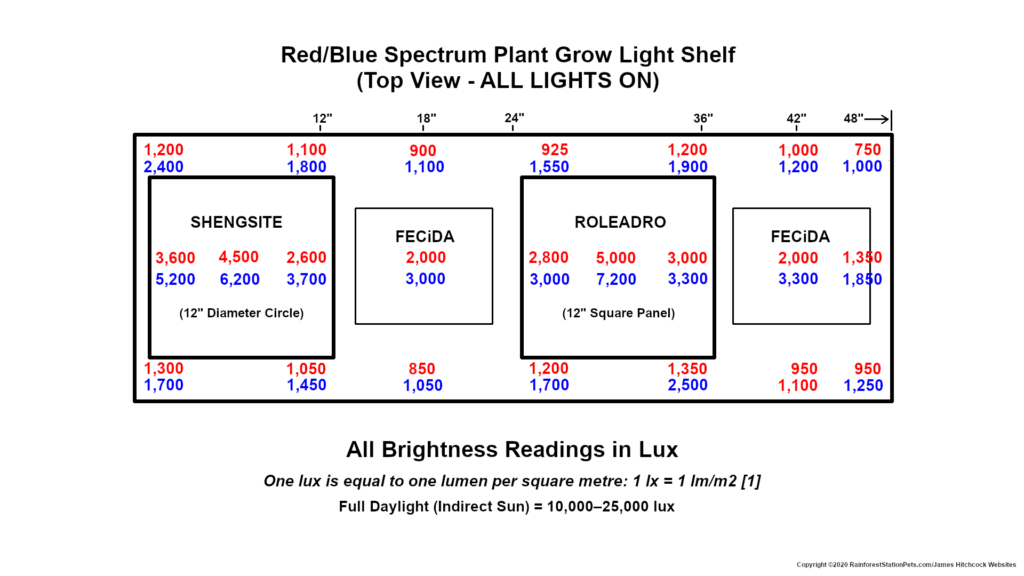
We started with two Lithonia Lighting shop lights on the control shelf (figure 3A), but decided to add a third Lithonia Lighting fixture (figure 3B) to the shelf to get the lux readings on the control shelf closer to the readings on the reconfigured Full Spectrum (figure 1B) and Red/Blue Spectrum (figure 2B) shelves.
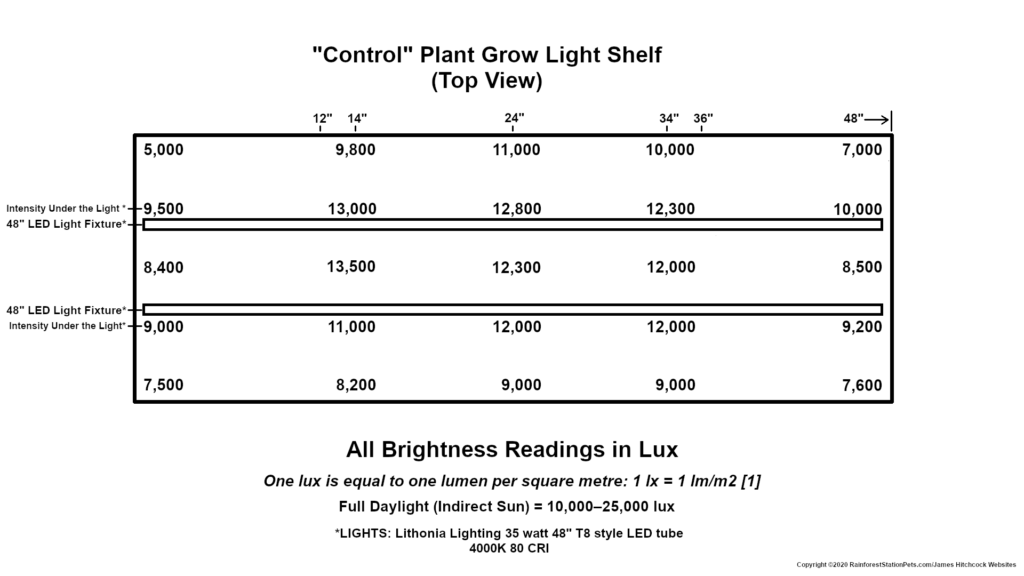
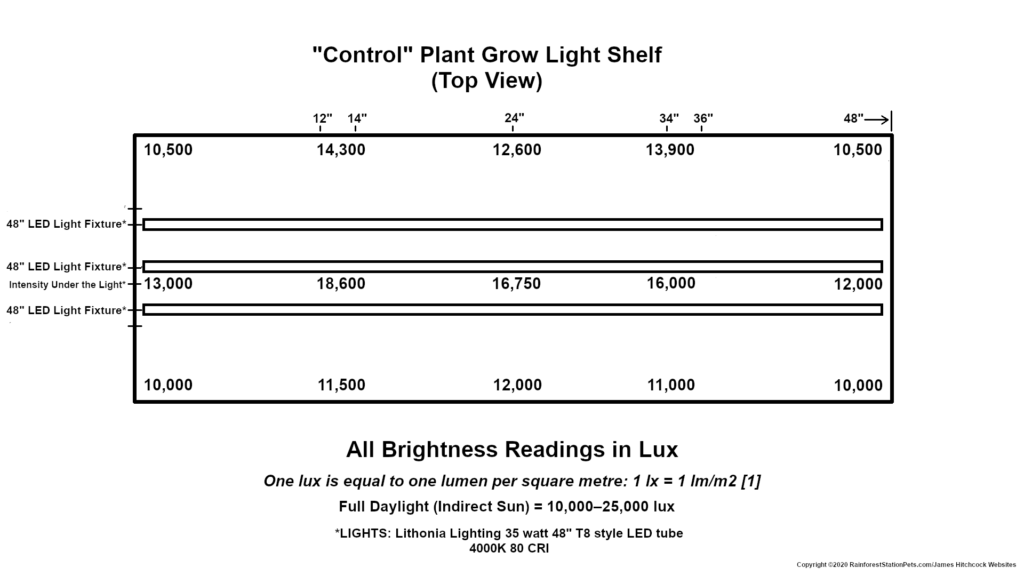
I left the original discussion above, as that was our original plan, and it only changed after purchase and installation. All the lights we actually used are listed and reviewed in the links below.
You can’t have a plant grow light shootout without plants, so here are photos of the plant trays from week to week:
Final thoughts:
While the plant tray photos allow you to compare the plants from week to week, here are some photos where I brought back together on December 21, 2020 the similar plants from all the trays. The numbered tags in each photo are tied to the tray, in which the lighting source was:
1. ECRU full-spectrum plant grow light
2. Roleadro full-spectrum plant grow light
Additional lighting on Full-Spectrum shelf: GE 24” LED plant grow light
3. Shengsite red/blue spectrum plant grow light
4. Roleadro red/blue spectrum plant grow light
Additional lighting on Red/Blue shelf: FeCIDA 50 watt 2-pack:
5. Lithonia Lighting 4000k T8-style tube (control)
6. Lithonia Lighting 4000k T8-style tube (control)
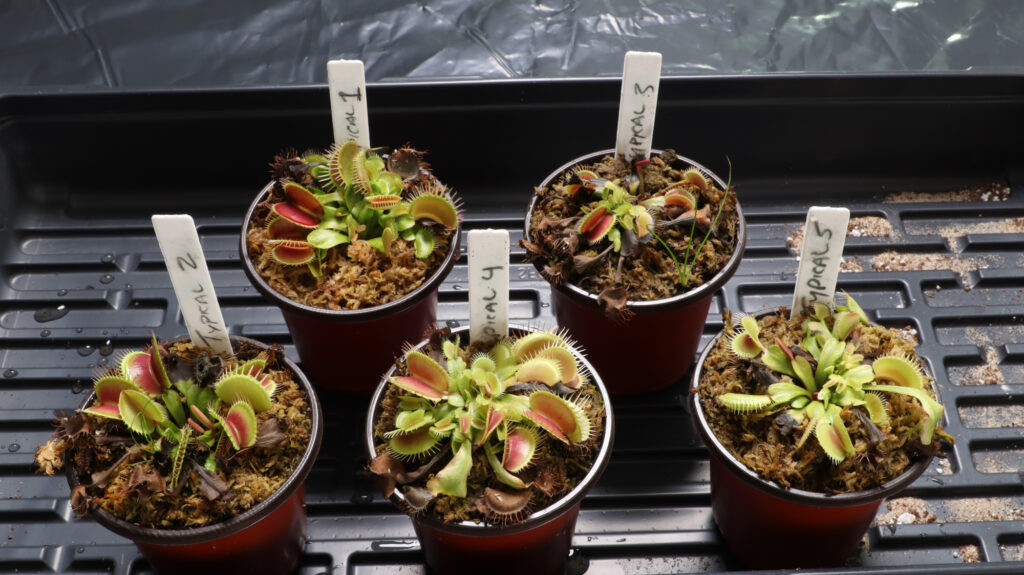
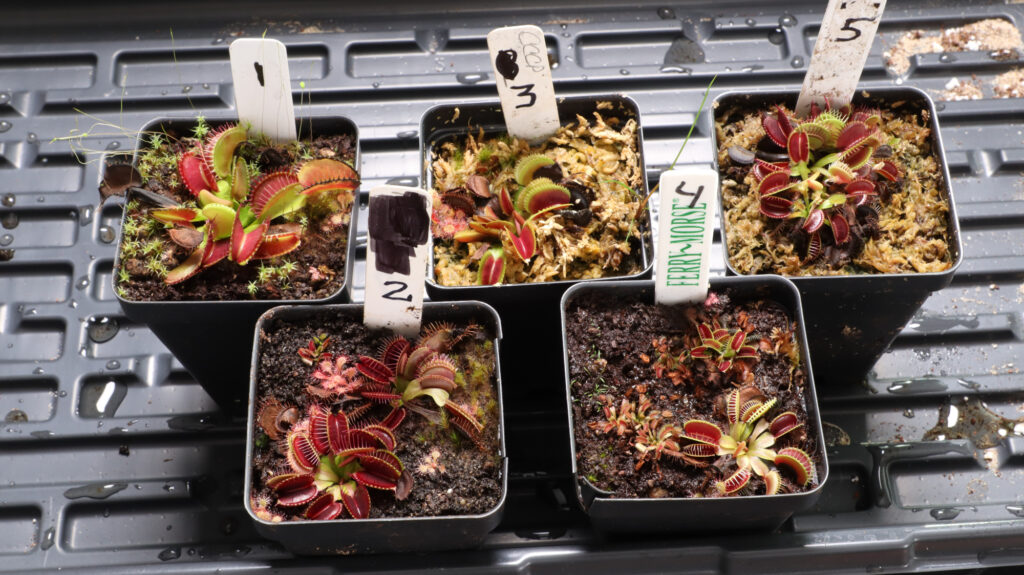
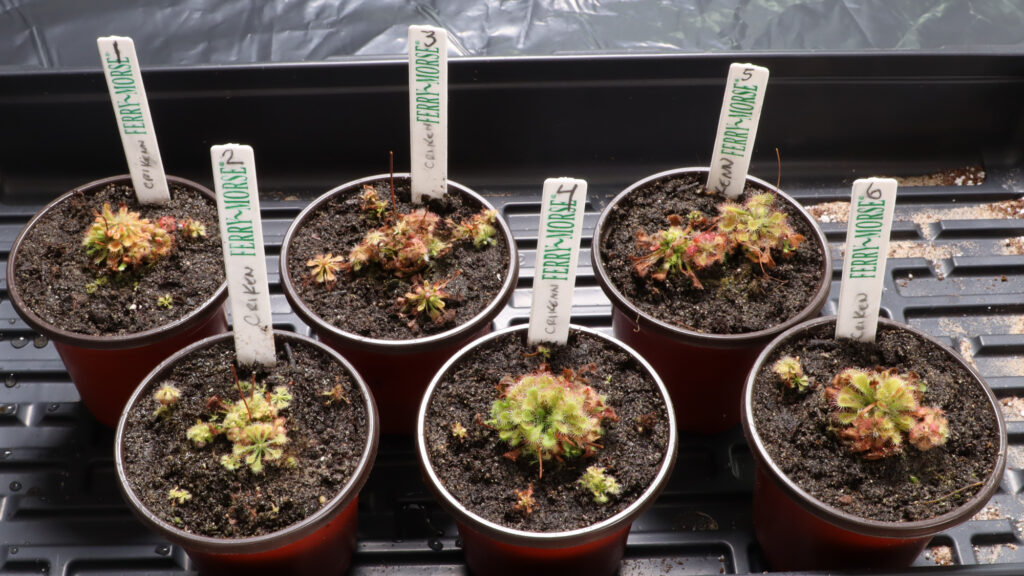
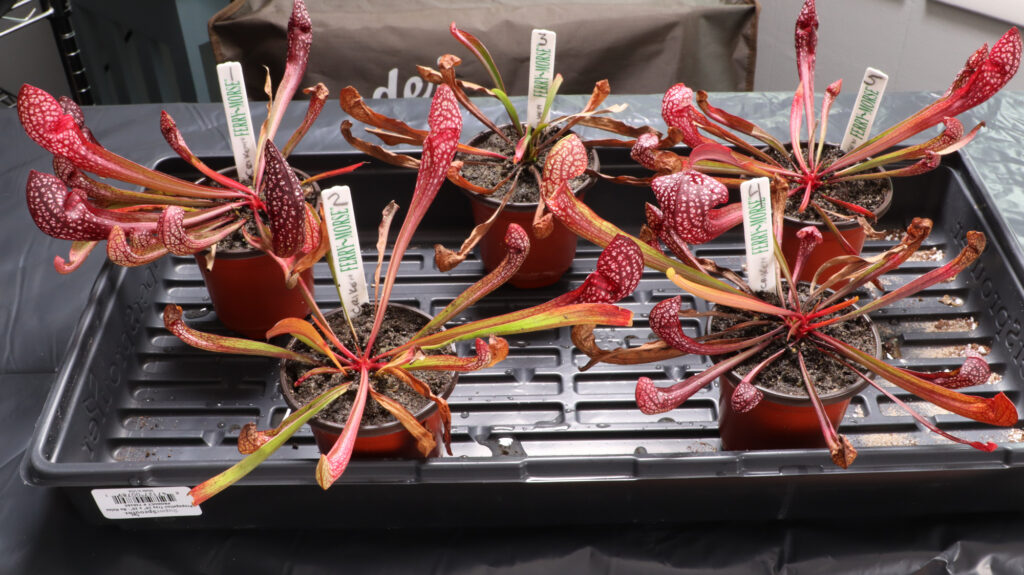
I would like to thank eBay sellers Crazy Craig’s Carnivorous Plants for the wide array of Venus Fly Traps and crikenny_0 for the cloned Drosera spatula and Saracenia x Scarlett Belle pitcher plants used in this test. Both of these sellers are great to work with and pack their plants with incredible care.
My final observations would be that some plants do better under red/blue plant grow lights than others. Almost all of the succulents did well under red/blue light, and the carnivorous plants that didn’t display a lot of red coloration did OK. But in my opinion, it seemed the carnivorous plants under full-spectrum light all outpaced the same plants under red/blue light. There was also very little difference between the carnivorous plants under the full-spectrum plant lights and the T-8 style utility lights, as long as the light from both were equal in lux. So, at this point I’m moving all the carnivorous plants to full-spectrum light and moving the succulents to the red/blue light for the remainder of winter.
I hope you’ve found this information helpful. Please watch for more to come.